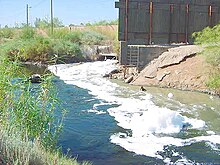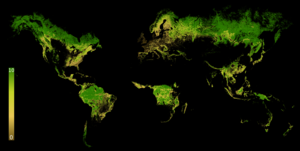Environmental issues
The examples and perspective in this article may not represent a worldwide view of the subject. (March 2020) |

Environmental issues are harmful effects of human activity on the biophysical environment.[citation needed][dubious ] Environmental protection is a practice of protecting the natural environment on the individual, organizational or governmental levels, for the benefit of both the environment and humans. Environmentalism, a social and environmental movement, addresses environmental issues through advocacy, education and activism.[1]
The carbon dioxide equivalent of greenhouse gases (GHG) in the atmosphere has already exceeded 400 parts per million (NOAA) (with total "long-term" GHG exceeding 455 parts per million) (Intergovernmental Panel on Climate Report). The amount of greenhouse gas in the atmosphere is possibly above the threshold that can potentially cause climate change. The UN Office for the Coordination of Humanitarian Affairs (OCHA) has stated "Climate change is not just a distant future threat. It is the main driver behind rising humanitarian needs and we are seeing its impact. The number of people affected and the damages inflicted by extreme weather has been unprecedented."[2] Further, OCHA has stated:
- Climate disasters are on the rise. Around 70 percent of disasters are now climate-related – up from around 50 percent from two decades ago.
- These disasters take a heavier human toll and come with a higher price tag. In the last decade, 2.4 billion people were affected by climate-related disasters, compared to 1.7 billion in the previous decade. The cost of responding to disasters has risen tenfold between 1992 and 2008.
- Destructive sudden heavy rains, intense tropical storms, repeated flooding, and droughts are likely to increase, as will the vulnerability of local communities in the absence of strong concerted action.[3]
Environment destruction caused by humans is a global, ongoing problem. By the year 2050, the global human population is expected to grow by 2 billion people, thereby reaching a level of 9.6 billion people.[4] The human effects on Earth can be seen in many different ways. A main effect, is an increase in global temperature. According to the report ”Our Changing Climate”, the global warming that has been going on for the past 50 years is primarily due to human activities.[5] Since 1895, the average temperature in the United States has increased by between 0.7 °C and 1.1 °C (1.3 °F and 1.9 °F), with most of the increase taking place since around 1970.[5][6][7]
Types[]
Major current environmental issues may include climate change, pollution, environmental degradation, and resource depletion. The conservation movement lobbies for protection of endangered species and protection of any ecologically valuable natural areas, genetically modified foods and global warming.
Scientific grounding[]

In 2006, many species were formally classified as rare or endangered or threatened; moreover, scientists have estimated that millions more species are at risk which have not been formally recognized. About 40 percent of the 40,177 species assessed using the IUCN Red List criteria are now listed as threatened with extinction—a total of 16,119.[9]
The level of understanding of Earth has increased markedly in recent times through science, especially with the application of the scientific method. Environmental science is now a multi-disciplinary academic study taught and researched at many universities. Many other scientific disciples, including ecology, toxicology, forest science, fisheries science, etc. are necessary for obtaining full scientific understanding. Credible, comprehensive, and readily accessible scientific knowledge is essential for addressing environmental issues.
Large amounts of data have been gathered and these are collated into reports, of which a common type is the State of the Environment publications. A recent major report was the Millennium Ecosystem Assessment, with input from 1200 scientists and released in 2005, which showed the high level of impact that humans are having on ecosystem services.
Organizations[]
Environmental issues are addressed at a regional, national or international level by government organizations.
The largest international agency, set up in 1972, is the United Nations Environment Programme. The International Union for Conservation of Nature brings together 83 states, 108 government agencies, 766 Non-governmental organizations and 81 international organizations and about 10,000 experts, scientists from countries around the world.[10] International non-governmental organizations include Greenpeace, Friends of the Earth and World Wide Fund for Nature. Governments enact environmental policy and enforce environmental law and this is done to differing degrees around the world.
Costs[]
This section needs expansion. You can help by . (October 2016) |
Solutions[]
The only question is whether [the world's environmental problems] will become resolved in pleasant ways of our own choice, or in unpleasant ways not of our choice, such as warfare, genocide, starvation, disease epidemics, and collapses of societies.
Sustainability is the key to prevent or reduce the effect of environmental issues. There is now clear scientific evidence that humanity is living unsustainably, and that an unprecedented collective effort is needed to return human use of natural resources to within sustainable limits.[12][13] For humans to live sustainably, the Earth's natural resources must be used at a rate at which they can be replenished (and by limiting global warming). This condition is measured by ecological footprint accounting.
Concerns for the environment have prompted the formation of green parties, political parties that seek to address environmental issues. Initially, these were formed in Australia, New Zealand, and Germany but are now present in many other countries.
Film and television[]
There are an increasing number of films being produced on environmental issues, especially on climate change and global warming. Al Gore's 2006 film An Inconvenient Truth gained commercial success and a high media profile.
See also[]
- Citizen Science
- Ecotax
- Environmental degradation
- Global issue
- Environmental impact statement
- Human impact on the environment
- Index of environmental articles
Issues
- List of environmental issues (includes mitigation and conservation)
Specific issues
- Environmental impact of agriculture
- Environmental impact of aviation
- Environmental impact of reservoirs
- Environmental impact of the energy industry
- Environmental impact of fishing
- Environmental impact of irrigation
- Environmental impact of mining
- Environmental impact of paint
- Environmental impact of paper
- Environmental impact of pesticides
- Environmental implications of nanotechnology
- Environmental impact of shipping
- Environmental impact of war
References[]
- ^ Eccleston, Charles H. (2010). Global Environmental Policy: Concepts, Principles, and Practice. Chapter 7. ISBN 978-1439847664.
- ^ OCHA. "Climate Change - Humanitarian Impact". Archived from the original on 2016-04-04. Retrieved 29 June 2017.CS1 maint: bot: original URL status unknown (link)
- ^ OCHA. "Climate Change - Threats and Solutions". Archived from the original on 2016-04-07. Retrieved 29 June 2017.CS1 maint: bot: original URL status unknown (link)
- ^ Living Blue Planet Report (PDF). WWF. 2015. ISBN 978-2-940529-24-7.
- ^ Jump up to: a b Walsh, et al. 20
- ^ "Our Changing Climate" (PDF).
- ^ "National Climate Assessment". National Climate Assessment. Retrieved 2017-05-20.
- ^ Grantham, H. S.; et al. (2020). "Anthropogenic modification of forests means only 40% of remaining forests have high ecosystem integrity". Nature Communications. 11 (1). doi:10.1038/s41467-020-19493-3. ISSN 2041-1723.
- ^ Lovett, Richard A. (2 May 2006). "Endangered Species List Expands to 16,000". National Geographic. Archived from the original on 5 August 2017.
- ^ "About". IUCN. 2014-12-03. Retrieved 2017-05-20.
- ^ Jared Diamond, Collapse: How Societies Choose to Fail or Survive, Penguin Books, 2011, chapter "The world as a polder: what does it all mean to us today?", section "If we don't solve them...", page 498 (ISBN 978-0-241-95868-1).
- ^ Gismondi, M. (2000). Interview of Dr. William Rees. Aurora Online. Retrieved on 2009-03-10
- ^ Millennium Ecosystem Assessment (2005). Ecosystems and Human Well-being: Biodiversity Synthesis. Summary for Decision-makers. pp.1-16. Washington, DC.: World Resources Institute. The full range of reports is available on the Millennium Ecosystem Assessment web site Archived August 13, 2015, at the Wayback Machine. Retrieved on: 2009-03-10
External links[]
 Media related to Environmental problems at Wikimedia Commons
Media related to Environmental problems at Wikimedia Commons
- Environmental issues
- Human impact on the environment
